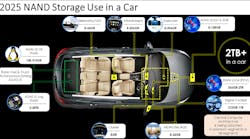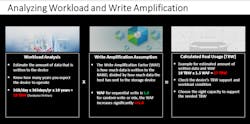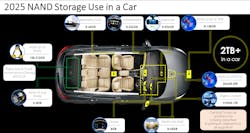What you’ll learn:
- The critical nature of workload analysis in the vehicle development stage.
- How workload analysis ensures vehicles can handle ever-evolving data demands.
- Why workload analysis is critical to innovation, enabling vehicles to accommodate new tech.
Although today’s automobiles still can’t fly, à la The Jetsons, they’re still vastly more technologically advanced than just a few years ago. Cars now support more lines of software code than fighter jets.
Lane-keep assistance, fast-charging batteries, cameras, voice recognition, and Wi-Fi are just a few of the systems common to modern cars. As a result of the ever-expanding amounts of data generated by these innovations, digital storage has become a key component in the evolution of the automotive industry. Keeping pace with that evolution is paramount to storage providers.
While enabling larger amounts of data storage is vital, it’s not the only requirement. The equipment and solutions involved also must provide the durability and longevity required by automotive systems. And they have to support features that enable monitoring. These systems must communicate to car owners the amount of storage space that’s available and when equipment needs replacing.
For auto manufacturers to properly equip their vehicles with high-performing and well-designed storage, they must understand the crucial role played by workload analysis.
The Importance of Workload Analysis
Storage workload analysis enables a proactive evaluation of how the system is accessing the storage device and the resulting useful life that can be expected. This analysis can bring to light the potential of exceeding the specifications of the storage device. Adjustments to the application software or increasing the storage-device capacity can then be made to reach the optimal years of useful life.
Some of the questions that workload analysis can help answer include:
- How much data is read and written per day in a target system?
- Do unexpected or unique data patterns exist in the target system?
- What are the data transfers and what’s the implication on the write amplification factor?
Real-life workload analysis provides a better understanding about the automotive target system and what it needs from storage. For example, to satisfy a range of analytical and regulatory requirements, some data may be needed for varying amounts of time. Some data needed for only a few seconds is stored in dynamic random-access memory (DRAM). Other types, such as data related to mapping, operation, and application software, must be stored for longer periods.
Thus, different storage solutions are required to support different use cases. In addition, storage workload analysis can serve as the basis for creating future storage-system optimizations and innovations (Fig. 1).
This capability for workload analysis comes at a time when digital storage embedded into cars continues to support more demanding use cases and ground-breaking applications. Enhanced infotainment, advanced driver-assistance systems (ADAS), data-recording sensors and cameras, 3D mapping, and vehicle-to-everything communication (V2X) are transforming the industry. All are expected to generate and consume huge amounts of data.
Ensuring that storage technology develops at the same rapid pace as the technologies transforming the connected-car market is no easy task. Entirely new applications and capabilities—some capitalizing on 5G, artificial intelligence, machine and deep learning, big data analysis, and more—are expected to bring enormous change to the auto industry in coming years.
Rapidly Increasing Workload Demands
As consumer expectations rise and storage workloads increase, an automobile’s requirements must be reevaluated.
While smartphone developers have seen their workloads increase gradually over time, the automotive industry is expected to see an incremental increase in storage usage resulting from autonomous-drive complexity and regulation requirements.
The next several years are likely to bring a host of new data-demanding capabilities, all requiring significant onboard data storage. NAND storage, relied on to handle the demands for vehicle features, could reach 2 TB by 2025, according to estimates by Western Digital (Fig. 2). As for commercial-fleet vehicles, they could soon require much more storage, as these vehicles will be collecting data to increase efficiency and help businesses gain insight into the fleet’s operations.
Workload Analysis is Critical to Innovation
Workload analysis is composed of four key stages:
- Bring up the infrastructure: The main goal is to enable a tracer that will capture all desired storage events on the target automotive system.
- Workload definition: The goal is to define the profile of user activities on the target system.
- The workload experiment: Huge trace logs are captured while running the defined workload.
- System analysis: The captured workload logs go through a post-processing system called write amplification factor (WAF).They’re analyzed for insights and conclusions around system and storage patterns and behaviors. The insights derived can help determine the expected useful life of the storage device.
The workload analysis process is used during product design to ensure that vehicles receive the best storage for their needs. Conducting workload analysis as a repetitive routine on evolving product development allows for the identification of changing trends and unexpected patterns. It also prevents unnecessary issues within important automotive storage systems. Therefore, by the time vehicles go to market, they’re prepared to handle ever-evolving data demands.
Automotive Storage in Action
In the continuously transforming automotive market, storage is expected to handle increasingly demanding applications with more mixed usages than ever before. As applications shift and workloads become more intense, storage becomes increasingly critical to support reliability, durability, and user experiences.
By performing workload analysis in the vehicle development stage, it’s easier to predict the expected behavior of the storage and its useful lifetime. Answering these kinds of questions produces better solutions for end users in the automotive industry. Check out this whitepaper to learn more.


